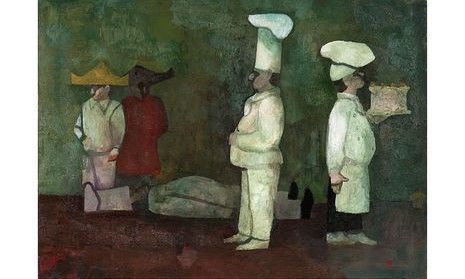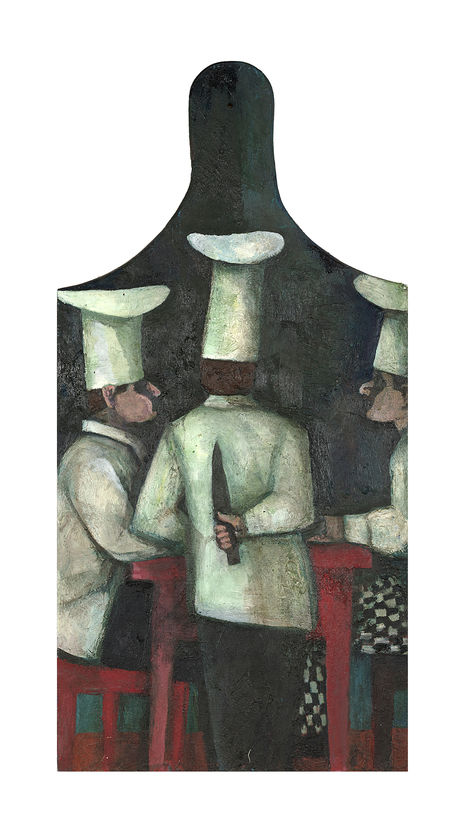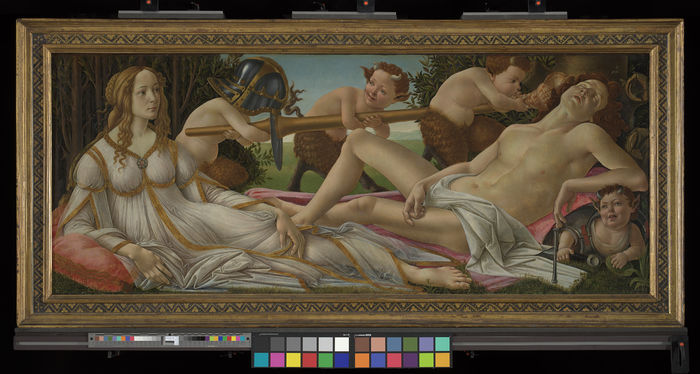‘On the Chopping Block’
Lucy Ansell talks to William Balthazar Rose about his recent exhibition at Clare Hall

Tired of consuming only lectures and reading lists? If you’re feeling peckish for some appetising art, I recently spoke to William Balthazar Rose, whose internationally renowned series ‘On the Chopping Block’ (recently showcased at Clare Hall) certainly provided some food for thought.
Artist William Balthazar Rose, born in Cambridge, was previously an architect before devoting himself to painting full time in 1990. He is best known for his ‘Cooks’ series, and viewing these titbits of an existential crisis, it’s not difficult to see why.
When viewing the exhibition, I found that the Shakespearean line “uneasy lies the head that wears a crown” came into my mind. For one simply cannot glance over the iconic Chef’s toque Rose depicts. Cutting against and dominating the pictures, the pointed hats demand attention. However, in paintings such as ‘What Do You Do with That? ’ (2023) they don’t look easy to carry; instead Rose paints them to be rigid and rather heavy.
“These macabre presentations of back-stabbing chefs ring true”
In this series, Rose follows the rich narrative of the cook’s profession to elegant yet critically pointed ends. Although Rose’s figurative style is (g)astronomically delightful, many of his paintings are purposely hard to digest. They invite onlookers into a culinary world which highlights inequality and isolation, often showcasing an abuse of power from authority figures. They explore the dark side of a kitchen culture which can be stressful and ruthless, and is predominantly organised around a hierarchical system. As Rose states, “cooks have their own laws”. Anyone who has watched Disney’s The Bear will recognise how these macabre presentations of back-stabbing chefs ring true.

Previously an architect, Rose attends carefully to spatial placement to “reinforce narrative”. Speaking to Rose, he stated how the “exhibition should be read as a text, and the placement of images considered in the light of the inner narratives of each painting. It is a story as an entirety”. In paintings such as ‘What Do You Do with That? ’ (2023), I see how the depictions of the rigid and heavy toques could be symbolic for Rose’s own experience of the “challenging exclusivity of professional disciplines”, which he suffered from when he felt the alienation of being a hybrid architect-painter.
“We are forced to suffer division: some are rich, some eat, and some starve”
In an essay he wrote specially for the Clare Hall exhibition, Rose explains how he utilises the tools of the cook’s profession to articulate symbolically ethical nuances of the human condition. He notes how eating is indicative of social inequality, as “we are forced to suffer division: some are rich, some eat, and some starve.” In our current cost of living crisis, Rose’s work skilfully presents to its viewers its own fictional ‘food chain’. The chefs who hold knives hold the power to control and divide, and those on the chopping block suffer alienation and mental isolation, as well as physical separation.
Ultimately, I felt that Rose’s work speaks most powerfully to the notion of creative burden, a threat all Cambridge students will relate to. Although it is often deemed humble, cooking, especially fine dining, is undeniably an art form. And like chefs, we students serve up our supervisors essays which are either savoured delicately, or regurgitated back up in cutting ‘academic discussion.’ Studying is not always a piece of cake, and paintings such as ‘Dog Food’ (2020-23) and ‘Does it smell? ’ (2020-23) capture the utter anxiety of turning in a shoddy essay.
What also strikes me in Rose’s paintings is the question of self-nourishment. While astutely presenting what he identifies as the compromise of the chef, who grapples between making a livelihood and producing an artistic, edible commodity, Rose investigates this element of self-sacrifice further. By showing behind the scenes stills of the chefs, Rose creates a painted space to ask the intimate query: who provides for the provider? With burnout, mental fatigue and the absence of a reading week being a common experience at our university, perhaps this will resonate with you. Rose’s exhibition prompted its audience to introspectively examine how we as students can balance creation, livelihood, and the demands of our degrees into a hectic 8 week term. Like these cooks, sometimes I think, can we ever have our cake and eat it too?
However, Rose’s pictures are not all grim, gourmet scenes of oppression. They are fanciful, playful, and the miniature chefs who huddle together so seriously look oddly endearing. You can sense hints of hope, trust and humour in Rose’s culinary world by the way the cooks stand tall and proud, fussing over each other and their cakes. For this reason, one of my favourites of his paintings has to be ‘Did He Eat Too Much? ’ (2020/23). The painting encapsulates the series’ tragi-comic nature, with a cook lying on the floor, surrounded by others.
Rose emphasised to me how his “work is a commentary upon the alchemy of painting, and the potential failure of the artist.” Sometimes things break down, we bake a bad cake, and Rose’s paintings manage to navigate this delicate recipe of life’s sacrifice, work and gateau. But, as Rose further commented, “perhaps [this] failure is necessary, perhaps we need to confront failure and understand failure.” After looking at these existential sweet treats, I can say that I fully agree. They remind us that nothing worth doing was ever a piece of cake, and studying should not be so.
 News / Cambridge postgrad re-elected as City councillor4 May 2024
News / Cambridge postgrad re-elected as City councillor4 May 2024 News / Gender attainment gap to be excluded from Cambridge access report3 May 2024
News / Gender attainment gap to be excluded from Cambridge access report3 May 2024 News / Some supervisors’ effective pay rate £3 below living wage, new report finds5 May 2024
News / Some supervisors’ effective pay rate £3 below living wage, new report finds5 May 2024 Comment / Accepting black people into Cambridge is not an act of discrimination3 May 2024
Comment / Accepting black people into Cambridge is not an act of discrimination3 May 2024 News / Academics call for Cambridge to drop investigation into ‘race realist’ fellow2 May 2024
News / Academics call for Cambridge to drop investigation into ‘race realist’ fellow2 May 2024




